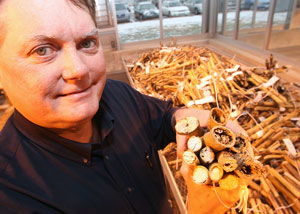 The National Biodiesel Board continues to like what it sees when it comes to the incoming Obama Administration.
The National Biodiesel Board continues to like what it sees when it comes to the incoming Obama Administration.
The primary advocacy group for the green fuel sent out congratulations to former Iowa Governor Tom Vilsack who was nominated to serve President-elect Obama as the next U.S. Secretary of Agriculture:
Following the announcement, Joe Jobe, the CEO of the National Biodiesel Board (NBB), released the following statement:
“Governor Vilsack is an excellent choice to head the Department of Agriculture (USDA). His executive experience as governor along with his unwavering support of biofuels reflects the President-elect’s commitment to biodiesel, an issue he had highlighted as a priority during his campaign.
“There is no question Secretary-designate Vilsack will face many challenges in the future, but I am confident in his ability to promote the economic, environmental and energy benefits of biofuels and ensure that policy at the USDA will benefit both agriculture producers as well as the biodiesel industry.”
Vilsack’s nomination… and approval by the NBB… comes on the heels of four other NBB-pleasing nominations earlier this week: Dr. Steven Chu, who has been tapped to serve as the U.S. Secretary of Energy; Carol Browner, who was named to the new position of White House Coordinator of Energy and Climate Policy(commonly called the Energy Czar); Lisa Jackson, who will head the Environmental Protection Agency (EPA); and Nancy Sutley to serve the President-elect as the lead White House Council on Environmental Quality.




 According to a statement from RFA, “Some have misconstrued this communication as a request for federal assistance or a bailout. To the contrary, the RFA recognizes that by stimulating increased production, innovation, and investment in new technologies and cellulosic feedstocks, a revitalized renewable fuels industry can help bail out the flagging US economy and lessen America’s dependence on foreign oil.”
According to a statement from RFA, “Some have misconstrued this communication as a request for federal assistance or a bailout. To the contrary, the RFA recognizes that by stimulating increased production, innovation, and investment in new technologies and cellulosic feedstocks, a revitalized renewable fuels industry can help bail out the flagging US economy and lessen America’s dependence on foreign oil.” Last week,
Last week,  Scott Johnson, manager of Sustainable Oils of Bozeman, says Japan Airlines will stage a one-hour flight using a jet fuel made from his company’s camelina on January 30, in Tokyo.
Scott Johnson, manager of Sustainable Oils of Bozeman, says Japan Airlines will stage a one-hour flight using a jet fuel made from his company’s camelina on January 30, in Tokyo. According to media reports, President-elect Obama will announce former Iowa governor Tom Vilsack as his choice for secretary of agriculture at a press conference scheduled for Wednesday. Obama also plans to announce his nomination of Colorado Sen. Ken Salazar as interior secretary at the same news conference.
According to media reports, President-elect Obama will announce former Iowa governor Tom Vilsack as his choice for secretary of agriculture at a press conference scheduled for Wednesday. Obama also plans to announce his nomination of Colorado Sen. Ken Salazar as interior secretary at the same news conference. As interior secretary, Salazar will head a department that oversees oil and gas drilling on public lands and manages the nation’s parks and wildlife refuges and will play a key role setting the new administration’s environmental, energy and land-use policies.
As interior secretary, Salazar will head a department that oversees oil and gas drilling on public lands and manages the nation’s parks and wildlife refuges and will play a key role setting the new administration’s environmental, energy and land-use policies. 
 Gas prices might be down… for now… but people are still thinking economy and green fuels when looking for a new vehicle.
Gas prices might be down… for now… but people are still thinking economy and green fuels when looking for a new vehicle.